Jim Casada Outdoors
October 2014 Newsletter
Click here to view this newsletter in a .pdf with a white background for easy
printing.
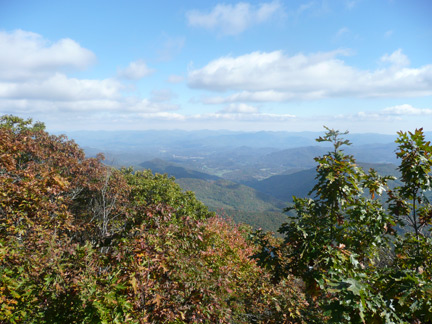
A “see forever” Indian Summer day in the Smokies.
Jim’s Doings
|
October
is always a busy month for me if for no other reason
than that it involves the opening of deer season. This
year, however, there’s much more.
I’m the
conference chairman for the 50th anniversary
conference of the Southeastern Outdoor Press Association
(SEOPA) as well as the organization’s incoming
president. Planning for that golden anniversary
gathering, which will be taking place in my own highland
homeland in Fontana Village, N.C., the location where,
back in 1964, 18 writers established the outdoor
communicators’ group.
It’s a
delight to be able to showcase the part of the world
which will always be the home of my heart as well as
the place of my birth, and two of the highlights of the
program feature people who share my love of the region.
One is my brother, Don, who will be talking about his
adventures, in a sort of combo photographic safari and
excursion into the past, in a presentation entitled
“Bushwhacking Through the Backside of Heaven.”
|
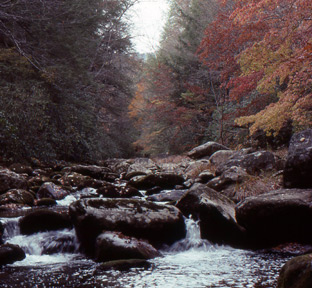
Big Santeetlah Creek (Graham
County, N.C.)
in its fall glory.
|
The
second is a good friend, Tipper Pressley, the gracious
genius with chinquapin eyes who hosts a daily blog, "Blind Pig and the Acorn,” every day of the year. She
will be talking about “Bloggin’ from the Heart” as she
shares her dedication to all aspects of the mountain way
of life.
There are many other programs, all sorts of
spouse activities, involvement of a number of young
folks of high school and college age who are aspiring or
promising communicators, chances to sample and savor all
that is new and noteworthy in outdoor products, an
awards ceremony and banquet, and dealing with 225-250
people.
Thank
goodness SEOPA has an exceptionally devoted and highly
competent executive director, because she’s the one who
makes all of this come together, more or less seamlessly
and despite my almost daily blunders which threaten to
mess something up (she even reads this newsletter,
perhaps just to keep me, as one of her putative bosses,
happy). Obviously this is a membership only affair, and
I say that because I wish some of you could attend.
I
will note that one subscriber, O.P. Holder, who is a
resident of Graham County where the conference is being
held, was gracious and generous to the nth degree
through making a lovely turkey call for an auction
associated with the event. A hearty tip of the hat to
him.
Once
that is behind me, I’ve got another writers’ conference
the following week (our little group here in S.C.) and
then some duties connected with an alumni advisory group
I serve on linked to my undergraduate alma mater, King
University in Bristol, Tenn.
Towards the end of the
month I’ll catch my breath, go deer hunting, and get
back to something approaching a daily routine.
Meanwhile, bear with me. I’ll try to have a mid-month
edition, complete with some book offerings and other
information, but for now here are some warm and
hopefully winsome thoughts on the enduring wonders of
the month we call October. It’s a grand time of year.
Back to Top
October Was Always The Best
I’ve always had a special fondness for the month of October. To
be sure, the earth’s reawakening in April is awesome, May
carries a special magic, and I can even find solace in the lean,
mean times of little February. But honesty compels me to
acknowledge that, all things considered, October has to be
reckoned my favorite month of the year. Here’s a sampling of why
that’s the case.
-
October is a vision of earthly gold, with hickories serving
as sentinels of autumn high atop hilltops and poplars
painting a picture no artist can hope to match.
-
It’s a squirrel high up in one of those hickories, cutting
away on a tasty nut or barking angrily when the shadow of a
hawk passes by in the sun of Indian Summer.
-
It’s memories of being
alongside Grandpa Joe in the corn field,
listening to him tell tales of those glorious days when
chestnuts reigned supreme in high country forests and seeing
him come about as close to being visibly emotional as would
ever happen. The thoughts of those mighty trees and all that
they had once meant to the mountain way of life—acid wood
for cash money; timber for barns, roofing shakes, or split
rail fences; nuts to roast at home, use in dressing, or
sell to be shipped to roast chestnut vendors in the city;
and the perfect mast for fattening free-range hogs—would
bring a catch to his voice and a glistening of moisture to
his eyes.
-
Mention of chestnuts, hogs, and Grandpa brings to mind
another fine feature of Octobers from yesteryear. It was the
month for fattening hogs, chestnuts or not, and that meant
pulling up armloads of red-rooted pigweed and carrying it to
the pig sty, shelling corn by hand after it had been pulled
from the dry stalks of the Hickory Cane variety Grandpa
favored, offering the swine plenty of surplus pumpkins which
maybe had a flaw or didn’t quite meet the requirements for
household use, and plenty of hard work.
-
The month carried its potential burden of pain from yellow
jacket stings or a chance encounter with a packsaddle while
working in the corn field.
-
It was the time of aptly named October beans. Also known as
corn field beans, they were allowed to dry on the vine. The
pods would then be stripped from the vines, spread atop a
big “blanket” made from tow sacks stitched together, and
dried a bit more in the afternoon sun. When dry to the point
of being almost brittle, they would be thrashed with a flail
made from a hickory sapling with one end cut so as to
consist of scores of tiny wooden strips. The beans could
then be winnowed from the hulls and stored for delicious,
hearty meals come dead of winter.
-
October meant harvested apples and freshly squeezed cider,
apple peeling and drying, and the promise of fried apple
pies (see information below) once fall gave way to winter.
-
It was big bowls of stewed apples on the table for every
meal, maybe hot with a pat of butter at breakfast and
dinner, and cold at supper (dinner means the mid-day meal in
my vocabulary, and it was often the main meal of the day in
my boyhood).
-
A regular ritual of October was pulling corn from the stalks
where it had dried in the field and hauling it to the crib.
If you had a good mouser (cat) available, that would suffice
to keep rodents at bay. If not, then other steps, such as
carefully set traps, were required. Maybe it’s because
12-year-old boys have a naturally bloodthirsty streak along
with being three parts poacher, but I actually enjoyed
dealing with the mice when it came to setting (and emptying)
traps.
-
It was the month when fall crops, planted somewhere around
Labor Day, began to provide welcome additions to the daily
diet and promise of good things to come. Mustard and turnip
greens were at the top of the list, along with fall cabbage,
but Grandpa Joe also planted radish and black-seeded Simpson
leaf lettuce. In my own approach to gardening, expanding on
his approach, I’ve included Swiss chard, spinach, broccoli,
and cauliflower.
-
I loved being a part of the harvest—carefully gathering
pumpkins, which would be stored for protection either in the
cool recesses of the cannery or on a bed of dry leaves
carefully and fully covered by corn shocks which were cut
with a hand sickle and stacked by Grandpa. He had a way of
doing it in a teepee-like shape which shed rain wonderfully
well.
-
October was and is a time of delight when it
came to treats
from nature. It’s finding ground cherries all through the
corn field and picking the best looking ones, golden little
globes with a taste that was sweet with just the slightest
hint of sour in the background. Or as a boy maybe a stroll
down the road along the river would give me a pocket bulging
with beech nuts. Hulling them is a lot of work for a tiny
treat, but my are they fine. No wonder every critter in the
woods flocks to beech trees in the years (rather rare) when
they bear mast.
-
It once was a school boy rich beyond monetary measure
because he had the pockets of his overalls (yes, some school
boys still wore overalls) jammed full of chinquapins to
share with his buddies and eat at recess. Speaking of
overalls, I recently purchased a pair and I’ve got to say,
never mind what my long-suffering wife thinks about their
appearance, that they are comfortable and functional to a
degree which makes me wonder why they ever faded from
popularity. After all, you don’t have to worry about a belt,
about your overly ample stomach having a bothersome
overhang, figuring out where to put your pocket knife or
hang a hammer, and they give plenty of crotch room unlike
the tight abomination sold as men’s britches in today’s
world.
-
October is ground fogs in the morning and ground hogs busily
feeding in the gloaming.
-
It’s yellow jackets in a state of steady anger because they
somehow know that their glory days are limited.
-
It’s molasses time in the mountains, with old-timers
reckoning that producing good cane syrup is a vanishing art
and a n’er-do-well or two looking for every opportunity to
get the skimmings (which usually carry more than a hint of
alcoholic content).
-
It’s a biscuit hot from the oven, split open, generously
covered with butter, and then doused with the first run of
molasses, the last run of honey, freshly made apple butter,
or fox grape jelly left over from a run of canning.
-
It’s gathering the fox grapes for that jelly, keeping a wary
eye out for hornets and copperheads, knowing that the end
result is worth every bit of the trouble involved.
-
October is a persimmon pudding topped with cream, so sweet that it’s no wonder a ripe persimmon is
sometimes called “nature’s candy.” Or it’s a mischievous
country boy managing to get his uppity city slicker cousin
to bite into a persimmon which is golden in color but still
hard and astringent. The reaction of those city types on
such occasions was a glory to behold, as they spit to beat
the band and felt like their mouth had suddenly grown a
heavy coat of fur.
-
It’s the slightly earthy, wonderfully sweet, banana-like
with a hint of mango taste (if I sound like one of these
wine snobs trying to describe flavors, and I probably do,
I’ll just cease and say the taste is basically
indescribable) of a pawpaw picked ripe from the tree just
before it fell. No wonder a pawpaw custard was George
Washington’s favorite dessert.
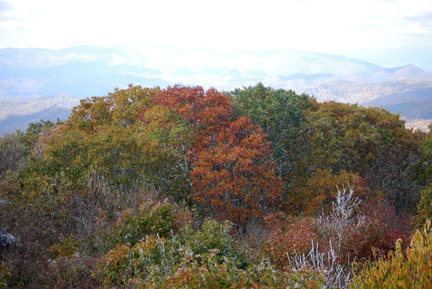
Wayah Bald in Macon County, N.C. in early fall.
Back to Top
Recipes
OCTOBER BEANS
The October beans mentioned above are quite large and speckled with
splotches of brown or red color. Used as a soup bean or by themselves,
they are as tasty as they are hearty. Both Momma and Grandma Minnie
prepared them in a simple way and often used them as a main course for
winter meals. They would wash and drain the beans two or three times,
checking closely to remove any foreign material from them, and then
place in a large pot half full of water and allow to soak overnight. The
following day they would add water and generous chunks of streaked meat
(salt pork), bring them to a rolling boil, and then cut the heat back to
a slow simmer. The beans would cook this way for several hours, perhaps
with the addition of a cup of water once or twice during the process.
The aroma from the cooking beans would fill every room of the house with
an almost irresistible odor. Often the beans, accompanied by a crusty
pone of cornbread and perhaps a bowl of turnip greens, would be our main
meal for the day.
FRIED APPLE PIES
Fried apple pies were a staple in the kitchens of both my mother and
grandmother throughout my boyhood, and I will still sacrifice all
pretense of gustatory dignity, any and all attention to dietary
restraint, when you place a hot fried pie made the proper way in front
of me. As for what constitutes the proper way, I won’t offer a recipe as
such but will give the essentials. You begin with sauce made from dried
apples, slow stewed and with a bit of brown sugar and perhaps a touch of
cinnamon added, with a good, thick sauce being best. Some folks use pie
dough while others opt for biscuit dough. I’m partial to the latter, not
because of any reservations about calories but simply because I think it
lets the apples provide the fullest flavor. Pies fried in a cast iron
skillet greased with a liberal coating of lard (the real McCoy in this
case, not some of the healthier substitutes—when it comes to fried pies
appetite correctness or the dictates of Michelle Obama-like dietary
naysayers belong in the trash can or trough), done one at a time and
topped off with a slathering of butter when they come hot from the pan,
and manna from mountain heaven. Or, as Grandpa was wont to opine,
“They’d bring tears of pure joy to a glass eye.”
|
PERSIMMON PUDDING
2 cups persimmon pulp
2 cups packed brown sugar
¼ cup butter, melted
1 teaspoon vanilla
1 ½ cups self-rising flour
½ cup light cream or whole milk
2 eggs, beaten
½ teaspoon cinnamon
½ cup raisins, pecans, or black walnuts (optional)
Combine all ingredients and beat just until well mixed. Pour
into a greased 9 x 13-inch pan and bake at 350 degrees for 30-35
minutes or until golden brown and just beginning to pull away
from the sides of the pan. Remove from oven and cool slightly.
Cover and seal tightly in foil or plastic wrap. When completely
cool cut into squares and serve with whipped topping. NOTE: This
is a very rich dessert and does not require large portions.
EASY PERSIMMON BUTTER
Wash persimmons thoroughly and remove stems and other debris.
Drain well. Press through a non-aluminum sieve to remove skins
and seeds. Add a bit of honey (to taste) and mix well with a
fork. Store in refrigerator and use as a spread on bagels,
biscuits, muffins, or toast.
FOX GRAPE JELLY
In my family at least, and study of regional cookbooks suggests
this is the case generally in the South, there was a pretty
simple, straightforward method for making fox grape jelly. One
of its advantages was that there’s enough natural pectin in fox
grapes to make the jelly set nicely without using anything
beyond fruit and sugar.
Start by squeezing the pulp from the skins and placing in
separate bowls. Remove the seeds from the pulp. This is easily
done with a plastic sieve with small holes. Discard the seeds.
Cook the skins until they are tender and then combine with the
pulp/juice mix which you have once the seeds have been removed.
For each cup of the recombined mixture add three-quarters cup of
sugar or to taste (some folks like fox grape jelly with a bit of
tart bite to it). Bring the mixture to a slow boil for 10 to 20
minutes, stirring frequently until it becomes noticeably thick.
At this point pour into half pint or pint jars and allow to
cool. Seal it with melted paraffin or two-piece lids. A cup of
fruit with the seeds removed will make about a half pint of
jelly.
PAWPAW PUDDING
1 cup of pawpaw pulp with all seeds removed
1 ¼ cup sugar
1 teaspoon baking powder
½ cup melted butter (the real thing)
1 teaspoon ginger (optional)
3 eggs
½ teaspoon salt
1 teaspoon baking soda
2 ½ teaspoons cinnamon
½ teaspoon nutmeg
Strain the pawpaw pulp using a plastic sieve. Mix it with all
the ingredients and bake in a well-greased pan for approximately
an hour at 350 degrees (when done it will begin to pull away
from the sides of the pan). Cool and cut into squares. |
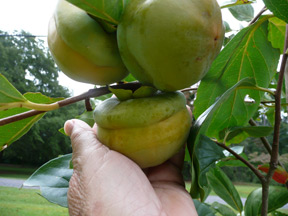
A trio of ripening persimmons, each
about the size of a flattened baseball.
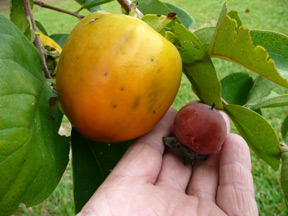
A ripe wild persimmon held next to a
ripening Asian persimmon to compare size.
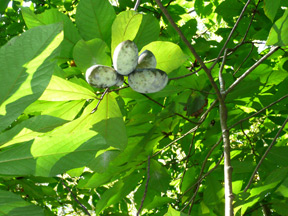
Ripening pawpaws in early autumn.
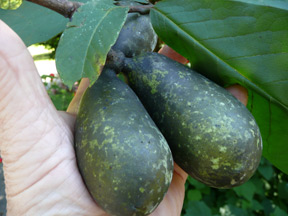
Pawpaws nearing readiness to pick. |
Back to Top
Thank you for subscribing to the
Jim Casada Outdoors
newsletter.
Feel free to contact Jim with your comments, questions
or suggestions at jc@jimcasadaoutdoors.com.
|






